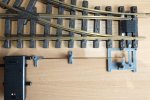LGB-Sid
Registered
Is anybody on here using Brass rod to control points or signals ? after buying two LGB point Motors and deciding they are really ugly things sat next to a set of points , I was thinking that if I use rodding I can then hide the motors or at least put them where I want them, plus if I am clever enough to work it out one Motor could control its points and assiociated signal. or if I was really clever one switch could control two sets of points that allow a cross over from one track to the other, as they always switch together 



